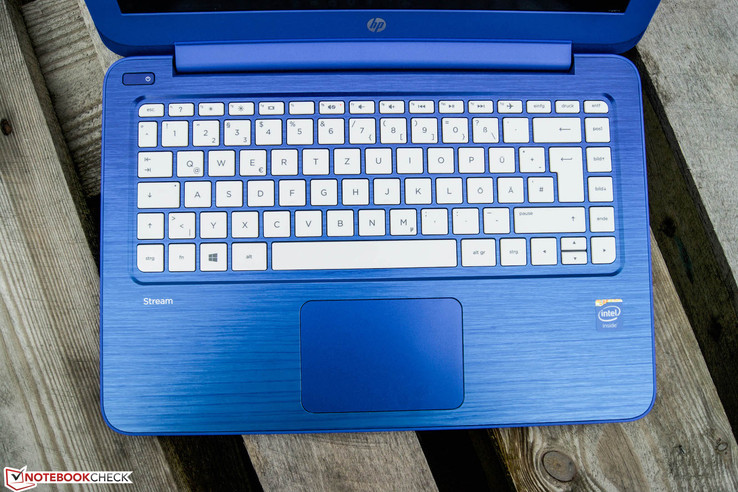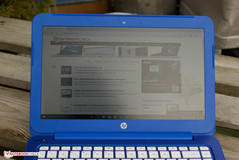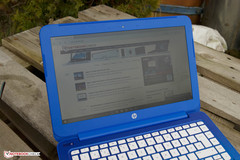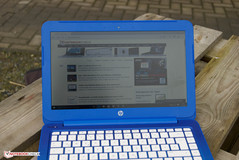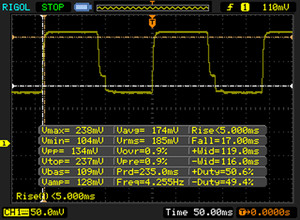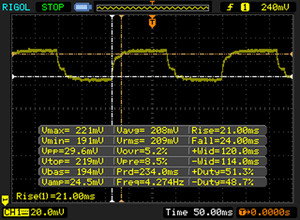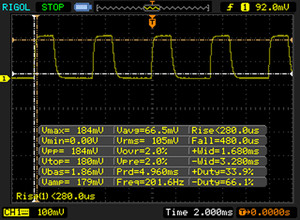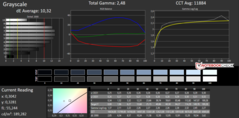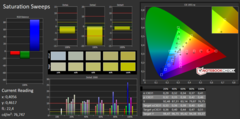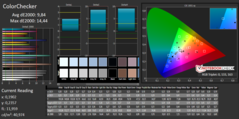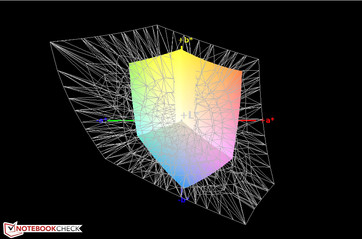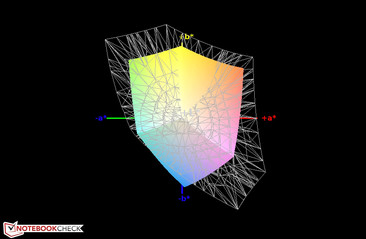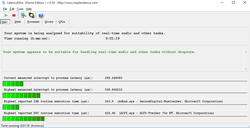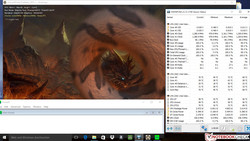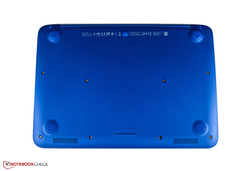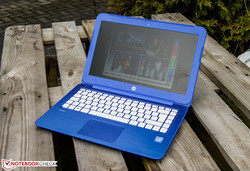HP Stream 13-c102ng Notebook Review

For the original German review, see here.
The second generation of the HP Stream 13-c100np retailing for just 300 Euros (~$338) is once again a colorful notebook, which is supposed to attract price-conscious users. The main difference is the processor upgrade from an Intel Celeron N2840 to an Intel Celeron N3050. Even though the price of the new version appears low, the device is actually 50 Euros (~$56) more expensive than the model we have already reviewed. The other components have not changed, so 2 GB of memory, a matte display with 1366x768 pixels and a small 32 GB eMMC for storage have to suffice. We can see a small change in terms of the storage: The included cloud storage is reduced from 1 TB to just 100 GB. On the other hand, you can now use it for two years instead of just one.
Case & Connectivity
The rich blue, which is called Cobalt Blue by HP, is a pleasant change from the otherwise boring notebooks and as a contrast, the keyboard is white. HP uses only plastic elements, but this is common for a notebook in this price range.
The handling of the notebook is convenient thanks to its weight of around 1.5 kg (~3.3 lb). The tactile feeling of the 2-cm (~0.8 in) high chassis is also okay and we cannot find any build quality issues. The display hinge is taut and leaves a robust impression, but you can dent the display lid slightly. You can quickly see that the 13-inch device is not designed to be maintained when you look at the bottom, not even the battery can be replaced. As with our previous review unit, even the memory is soldered and cannot be expanded.
You get one HDMI port as well as two USB ports, but only one of them supports the 3.0 standard. There is also a microSD-card slot. Similar to the predecessor, all the ports are located in the rear area, so there are no annoying cables when you are working.
Input Devices
We cannot find any changes compared to the predecessor in terms of the input devices. The chiclet keyboard can be pushed in slightly in the center and the key travel could be a little firmer. The good grip and the decent pressure point are positive aspects. All keys are sufficiently solid and do not wobble too much in the corners.
The surface of the touchpad (9.5 x 6.5 cm/~3.7 x 2.6 in) is extremely smooth and allows fast movements. However, the pad is not very responsive in the corners. You can use the mouse buttons with a short travel in the lower part of the touchpad. The clattering noises when you apply just a little bit of pressure to the pad are unpleasant.
Overall, the keyboard and the touchpad leave a very solid impression for this price range.
Display
The display was already a problem in the last version and unfortunately we cannot see a positive development. The panel with 1366x768 pixels manages a very low average brightness of only 179 cd/m². Particularly annoying: The brightness is reduced even further to 158 cd/m² on battery power. HP still uses a matte panel, so there are no reflections on the 13-inch device. However, the weak backlight cannot compensate for light sources. A much brighter panel is available in the 50 Euros (~$56) more expensive Acer Aspire E13, for example. It manages much brighter 254.4 cd/m².
| |||||||||||||||||||||||||
Brightness Distribution: 85 %
Center on Battery: 158 cd/m²
Contrast: 576:1 (Black: 0.33 cd/m²)
ΔE ColorChecker Calman: 9.84 | ∀{0.5-29.43 Ø4.83}
ΔE Greyscale Calman: 10.32 | ∀{0.09-98 Ø5.1}
60% sRGB (Argyll 1.6.3 3D)
38% AdobeRGB 1998 (Argyll 1.6.3 3D)
42.32% AdobeRGB 1998 (Argyll 3D)
59.8% sRGB (Argyll 3D)
40.68% Display P3 (Argyll 3D)
Gamma: 2.48
CCT: 11884 K
| HP Stream 13-c102ng HD Graphics (Braswell), N3050, 32 GB eMMC Flash | HP Stream 13-c002ng HD Graphics (Bay Trail), N2840, 32 GB eMMC Flash | Acer Aspire E13 ES1-311-P87D HD Graphics (Bay Trail), N3540, WDC Slim WD10SPCX-21KHST0 | Acer Aspire ES1-331-C5KL HD Graphics (Braswell), N3150, Seagate Momentus Thin ST500LT012-1DG142 | Toshiba CB30-B-104 HD Graphics (Bay Trail), N2840 | |
|---|---|---|---|---|---|
| Display | -13% | 9% | 12% | ||
| Display P3 Coverage | 40.68 | 35.05 -14% | 44.03 8% | 45.56 12% | |
| sRGB Coverage | 59.8 | 52.8 -12% | 65.8 10% | 68 14% | |
| AdobeRGB 1998 Coverage | 42.32 | 36.21 -14% | 45.52 8% | 47.12 11% | |
| Response Times | |||||
| Response Time Grey 50% / Grey 80% * | 45 ? | ||||
| Response Time Black / White * | 25 ? | ||||
| PWM Frequency | 201 ? | ||||
| Screen | 3% | -52% | -4% | 40% | |
| Brightness middle | 190 | 210 11% | 279 47% | 289 52% | 378 99% |
| Brightness | 179 | 205 15% | 254 42% | 266 49% | 374 109% |
| Brightness Distribution | 85 | 92 8% | 86 1% | 87 2% | 94 11% |
| Black Level * | 0.33 | 0.43 -30% | 1.71 -418% | 0.68 -106% | 0.5 -52% |
| Contrast | 576 | 488 -15% | 163 -72% | 425 -26% | 756 31% |
| Colorchecker dE 2000 * | 9.84 | 11.95 -21% | 10.73 -9% | 10.9 -11% | |
| Greyscale dE 2000 * | 10.32 | 1.42 86% | 11.98 -16% | 12.65 -23% | |
| Gamma | 2.48 89% | 2.31 95% | 2.19 100% | 2.11 104% | |
| CCT | 11884 55% | 6504 100% | 13164 49% | 14520 45% | |
| Color Space (Percent of AdobeRGB 1998) | 38 | 34 -11% | 42 11% | 42 11% | |
| Color Space (Percent of sRGB) | 60 | 53 -12% | 67.9 13% | ||
| Total Average (Program / Settings) | -5% /
-1% | -22% /
-35% | 4% /
-0% | 40% /
40% |
* ... smaller is better
Display Response Times
| ↔ Response Time Black to White | ||
|---|---|---|
| 25 ms ... rise ↗ and fall ↘ combined | ↗ 7 ms rise | |
| ↘ 18 ms fall | ||
| The screen shows relatively slow response rates in our tests and may be too slow for gamers. In comparison, all tested devices range from 0.1 (minimum) to 240 (maximum) ms. » 57 % of all devices are better. This means that the measured response time is worse than the average of all tested devices (20.5 ms). | ||
| ↔ Response Time 50% Grey to 80% Grey | ||
| 45 ms ... rise ↗ and fall ↘ combined | ↗ 21 ms rise | |
| ↘ 24 ms fall | ||
| The screen shows slow response rates in our tests and will be unsatisfactory for gamers. In comparison, all tested devices range from 0.165 (minimum) to 636 (maximum) ms. » 76 % of all devices are better. This means that the measured response time is worse than the average of all tested devices (32.1 ms). | ||
Screen Flickering / PWM (Pulse-Width Modulation)
| Screen flickering / PWM detected | 201 Hz | ≤ 30 % brightness setting | |
The display backlight flickers at 201 Hz (worst case, e.g., utilizing PWM) Flickering detected at a brightness setting of 30 % and below. There should be no flickering or PWM above this brightness setting. The frequency of 201 Hz is relatively low, so sensitive users will likely notice flickering and experience eyestrain at the stated brightness setting and below. In comparison: 53 % of all tested devices do not use PWM to dim the display. If PWM was detected, an average of 8327 (minimum: 5 - maximum: 343500) Hz was measured. | |||
We check the color and grayscale deviations with the software CalMAN. We can already see a blue cast and it is supported by the grayscale. The DeltaE deviations of around 10 for the grayscale and the colors are not impressive, but normal for a TN panel.
The outdoor usability is limited to cloudy days or places in the shade. The display will quickly appear too dark outdoors.
The TN panel offers limited viewing angles; the colors and the brightness in particular distort with vertical shifts. Another issue is the small opening angle of the display at just 125 degrees.
Performance
The visual appearance and the rather simple specification sheet remind us of a Chromebook from Google. HP's Stream 13 is therefore a rival based on Windows, but you only get the essentials for 300 Euros (~$338). This includes a frugal Braswell Intel Celeron CPU, 2 GB of memory and 32 GB of storage. Unfortunately, there are no other configurations available. The only choice is limited to the color: HP has dispensed with the pink model for the current line-up and offers a purple alternative instead.
Processor
The CPU is an Intel Celeron N3050 based on the Bramwell architecture. The two cores of the CPU run at 1.6 GHz, but the processor can reach clocks of up to 2160 MHz via automatic Boost. The performance is sufficient for daily tasks, but you will quickly reach the limit when you browse complex websites or during multitasking.
According to the manufacturer, the 64-bit CPU consumes only up to 6 W (TDP).
First, we have a closer look at the performance in the Cinebench R15 benchmark. The multi-core result of just 59 points indicates a rather weak performance. At least, the performance is not further reduced on battery power. The previously mentioned Acer Aspire E13 manages a much better score of 157 points thanks to its more powerful quad-core processor.
System Performance
Even though the Stream 13 does not feature very powerful hardware, the system always ran smoothly. There were only some hiccups during some animations and when we used multiple applications simultaneously. PCMark 8 gives us an objective result when we compare it with the predecessor. The previous Stream version is around 20% worse in the Home benchmark, while our review unit is slightly behind the previous generation in the Work test.
| HP Stream 13-c102ng HD Graphics (Braswell), N3050, 32 GB eMMC Flash | Acer Aspire E13 ES1-311-P87D HD Graphics (Bay Trail), N3540, WDC Slim WD10SPCX-21KHST0 | HP Stream 13-c002ng HD Graphics (Bay Trail), N2840, 32 GB eMMC Flash | Acer Aspire ES1-331-C5KL HD Graphics (Braswell), N3150, Seagate Momentus Thin ST500LT012-1DG142 | Lenovo IdeaPad 300S-11IBR HD Graphics (Braswell), N3050, Seagate Momentus Thin ST500LT012-1DG142 | |
|---|---|---|---|---|---|
| PCMark 7 | |||||
| Score | 2434 | 1635 -33% | |||
| PCMark 8 | 3% | -7% | 1% | -7% | |
| Home Score Accelerated v2 | 1568 | 1485 -5% | 1273 -19% | 1640 5% | 1511 -4% |
| Work Score Accelerated v2 | 1331 | 1470 10% | 1396 5% | 1283 -4% | 1205 -9% |
| Total Average (Program / Settings) | 3% /
3% | -7% /
-7% | -16% /
-11% | -7% /
-7% |
| PCMark 7 Score | 2434 points | |
| PCMark 8 Home Score Accelerated v2 | 1568 points | |
| PCMark 8 Work Score Accelerated v2 | 1331 points | |
Help | ||
Storage Devices
Similar to the previous version, HP uses eMMC storage with a capacity of 32 GB. Thanks to the Windows operating system, the preloaded software and the recovery partition, you can only use around 17 GB. The read rates are quite reasonable, which is typical for eMMC storage, but fall slightly behind the previous Stream 13. The write performance in particular is low. An expansion of the storage is only possible via microSD-card.
| HP Stream 13-c102ng HD Graphics (Braswell), N3050, 32 GB eMMC Flash | HP Stream 13-c002ng HD Graphics (Bay Trail), N2840, 32 GB eMMC Flash | Acer Aspire E13 ES1-311-P87D HD Graphics (Bay Trail), N3540, WDC Slim WD10SPCX-21KHST0 | Asus Transformer Book Flip TP200SA-FV0108TS HD Graphics (Braswell), N3050, 32 GB eMMC Flash | Lenovo IdeaPad 300S-11IBR HD Graphics (Braswell), N3050, Seagate Momentus Thin ST500LT012-1DG142 | |
|---|---|---|---|---|---|
| CrystalDiskMark 3.0 | -16% | -50% | 4% | -58% | |
| Read Seq | 152.8 | 171.2 12% | 99.5 -35% | 164.5 8% | 92 -40% |
| Write Seq | 76.9 | 69.9 -9% | 98 27% | 67.8 -12% | 80.3 4% |
| Read 4k | 18.28 | 19.57 7% | 0.415 -98% | 18.05 -1% | 0.308 -98% |
| Write 4k | 16.78 | 4.639 -72% | 1.161 -93% | 20.49 22% | 0.576 -97% |
GPU Performance
The graphics output is handled by the Intel HD Graphics (Braswell). It is clocked between 320 and 600 MHz and can handle 4K/H.265 videos smoothly. However, you will have to forget about gaming, only old classics can be played smoothly. 3DMark 11 confirms this with a low score of just 310 points. Still, this result is 36% better than the predecessor that scored only 236 points.
More comparisons and information about the graphics card are available in our article about mobile graphics cards.
| 3DMark 11 - 1280x720 Performance (sort by value) | |
| HP Stream 13-c102ng | |
| HP Stream 13-c002ng | |
| Acer Aspire E13 ES1-311-P87D | |
| Acer Aspire ES1-331-C5KL | |
| Lenovo IdeaPad 300S-11IBR | |
| 3DMark 11 Performance | 310 points | |
| 3DMark Ice Storm Standard Score | 15693 points | |
| 3DMark Cloud Gate Standard Score | 1404 points | |
Help | ||
Gaming Performance
The HP Stream 13 is not designed to play games. If you still want to play, you should focus on older classics or games from the Windows Store. “TrackMania Nations Forever” from 2008 is actually playable at the lowest settings. A list of games and their requirements is available here.
| Trackmania Nations Forever | |
| 640x480 Minimum Quality AA:0x AF:Bilinear (sort by value) | |
| HP Stream 13-c102ng | |
| HP Stream 13-c002ng | |
| Acer Aspire One Cloudbook 11 AO1-131-C58K | |
| 1024x768 High Quality AA:0x AF:4x (sort by value) | |
| HP Stream 13-c102ng | |
| HP Stream 13-c002ng | |
| Acer Aspire One Cloudbook 11 AO1-131-C58K | |
| low | med. | high | ultra | |
|---|---|---|---|---|
| Trackmania Nations Forever (2008) | 97.6 | 22.9 |
Emissions & Energy
Temperature
We noticed a very good temperature development in our last review of the Stream 13, despite the fanless construction. This version is also very comfortable while idling and we can only determine one hotspot at up to 51.6 °C (~125 °F) in one scenario. Fortunately, the keyboard area does not get very warm. However, this load scenario is very unlikely in practice and could only happen for a short while when you play games.
Now we look at the components in a stress test scenario. The processor will drop below its nominal clock after a few minutes and then level off at a steady 1.2 GHz.
(+) The maximum temperature on the upper side is 36.5 °C / 98 F, compared to the average of 33.1 °C / 92 F, ranging from 21.6 to 53.2 °C for the class Netbook.
(-) The bottom heats up to a maximum of 51.6 °C / 125 F, compared to the average of 36.6 °C / 98 F
(+) In idle usage, the average temperature for the upper side is 24.2 °C / 76 F, compared to the device average of 29.8 °C / 86 F.
(+) The palmrests and touchpad are cooler than skin temperature with a maximum of 26 °C / 78.8 F and are therefore cool to the touch.
(+) The average temperature of the palmrest area of similar devices was 29.3 °C / 84.7 F (+3.3 °C / 5.9 F).
Speakers
Voices and sounds are quite clear. The volume is also okay and sufficient to overcome some noises., On the other hand, the Stream 13 does not generate a rich sound.
Power Consumption
The test model is equipped exclusively with frugal and not very powerful components, which is also reflected by the power consumption: The HP Stream 13 only consumes 13.2 watts even under maximum load. It does not make much difference whether the device is in standby (0.3 W) or completely shut down (0.2 W).
| Off / Standby | |
| Idle | |
| Load |
|
Key:
min: | |
Battery Runtime
According to the specifications, the manufacturer uses the same 37-Wh lithium-ion battery as before. HWInfo, however, shows a 35-Wh module.
We determine the runtime during web browsing to simulate a realistic scenario. The review unit will hibernate after 6 hours, which is a good result. For comparison: The previously reviewed HP Stream 13 lasted one hour longer.
| Battery Runtime - WiFi Websurfing (sort by value) | |
| HP Stream 13-c102ng | |
| HP Stream 13-c002ng | |
| Acer Aspire E13 ES1-311-P87D | |
Pros
Cons
Verdict
Playful, youthful and alternative is the right description for the design of the new HP Stream 13. It is not the first time that we have had the chance to review a device from this series. Since the last version, the manufacturer has mainly replaced the processor and forgotten about the old problems. Once again, we can find a very solid build quality and input devices, but would have expected more in terms of the display. The choice of a matte panel is the only positive aspect about the otherwise bad screen.
In general, the new processor provides more performance and is sufficient for web browsing and office applications. The battery runtime is also more than satisfactory.
All in all, the HP Stream 13 is an inexpensive Chromebook alternative.
If you are looking for a Chromebook, but rely on Windows applications like Microsoft Office, the Stream 13 could be a real alternative.
You should still have a look at the competition, because they often provide more performance and a better display for a small additional charge.
HP Stream 13-c102ng
- 02/04/2016 v4.1 (old)
Nino Ricchizzi






